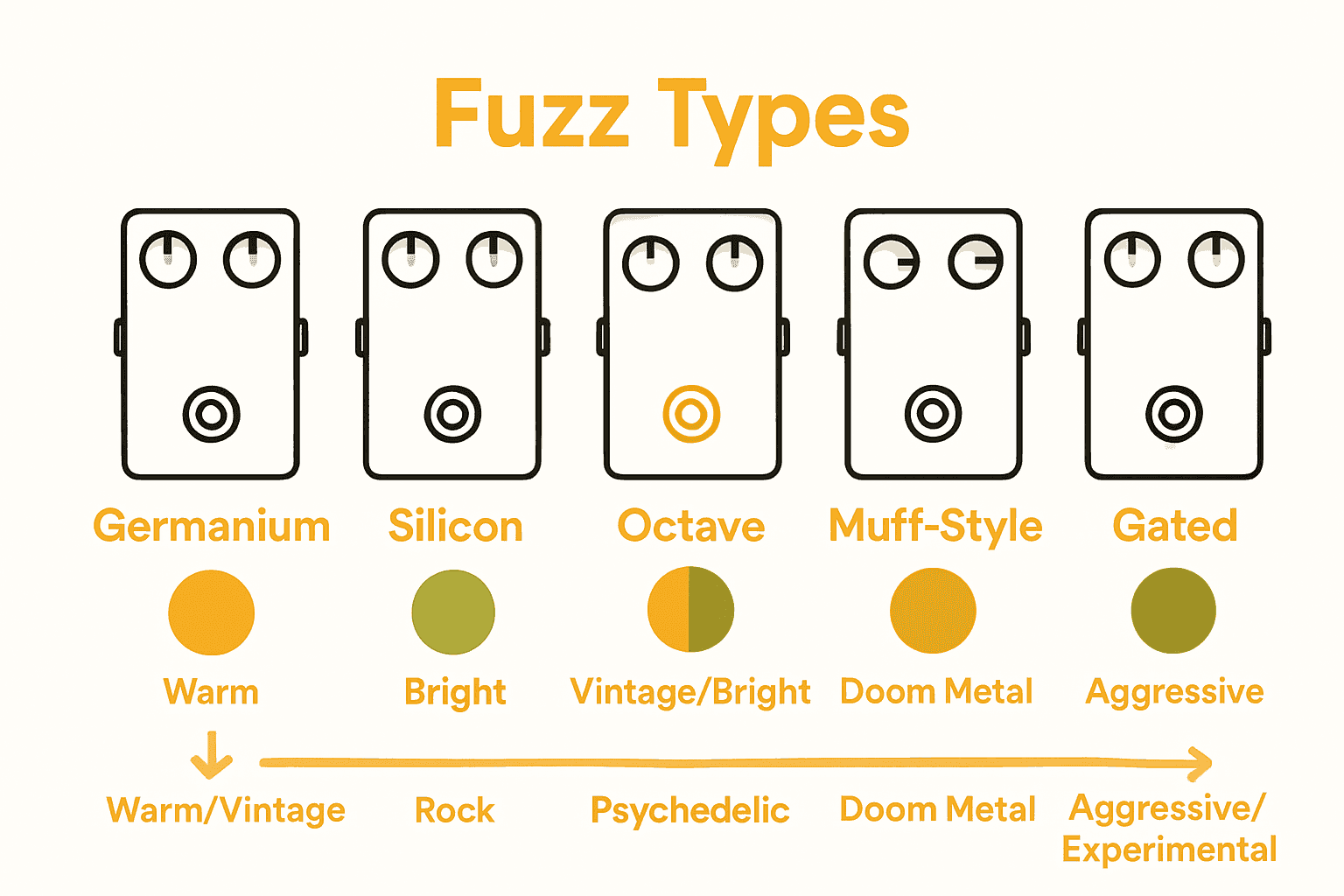Did you know the first commercial fuzz pedal was created by accident in 1961? This fuzzy, aggressive guitar sound changed music forever and quickly became a signature effect in rock and blues. From classic hits like the Rolling Stones’ “Satisfaction” to modern experimental tracks, the fuzz effect remains a favorite for musicians chasing bold, unique tones that stand out in any mix.
Table of Contents
- Fuzz Defined: Origins And Fundamental Concepts
- Common Types Of Fuzz Pedals Explained
- How Fuzz Effects Transform Your Guitar Tone
- Popular Uses In Modern And Classic Music
- Key Considerations When Choosing A Fuzz Pedal
Key Takeaways
| Point | Details |
|---|---|
| Origins of Fuzz | The fuzz effect originated from a technical malfunction in 1961, evolving into a key guitar sound that defines rock and blues genres. |
| Types of Fuzz Pedals | Different fuzz pedals, such as germanium and silicon, provide unique tonal qualities suited for various musical styles. |
| Transformative Power | Fuzz pedals reshape guitar tones by adding harmonic complexity and achieving dynamic compression, enhancing emotional expression in music. |
| Considerations for Selection | When choosing a fuzz pedal, consider factors like transistor type, tone control, and responsiveness to align with your musical style. |
Fuzz Defined: Origins And Fundamental Concepts
The fuzz effect is a unique guitar sound distortion technique that revolutionised electric guitar tone in the 1960s. Originating from an unexpected technical anomaly, fuzz represents a raw, gritty sonic transformation that turns clean guitar signals into a deliberately aggressive, saturated sound. According to Wikipedia, the first widely marketed fuzz distortion pedal emerged in 1962 with the Maestro FZ-1 Fuzz-Tone, which gained significant popularity in 1965 after Keith Richards used it on the Rolling Stones’ hit “Satisfaction”.
Interestingly, the fuzz effect wasn’t initially an intentional musical invention. Wikipedia documents that the effect was accidentally created in 1961 through a malfunction in bassist Grady Martin’s amplifier during a solo recording. This unexpected technical glitch introduced musicians to a completely new sound palette that would soon become a defining characteristic of rock and blues guitar playing.
At its core, fuzz is an electronic circuit that deliberately clips and distorts the guitar’s electrical signal, creating a thick, saturated tone that sounds almost like a controlled electrical breakdown. Unlike standard overdrive or distortion, fuzz produces a more extreme sound transformation - turning smooth guitar notes into a buzzing, woolly texture that seems to “explode” with each note. Musicians appreciate fuzz for its ability to add intensity, character, and an almost synthesiser-like quality to guitar sounds.
Key characteristics of the fuzz effect include:
- Extreme signal clipping and distortion
- A “woolly” or “buzzy” tone quality
- Reduction of dynamic range
- Significant harmonic enhancement
- Ability to transform clean signals into aggressive sounds
From its accidental origins to becoming a staple in rock, blues, and psychedelic music, the fuzz effect represents a fascinating intersection of technical malfunction and creative musical innovation.
Common Types Of Fuzz Pedals Explained
The world of fuzz pedals is rich and diverse, offering musicians a wide range of sonic possibilities. According to Wikipedia, one of the most iconic fuzz pedals is the Fuzz Face, first introduced in 1966. Initially using germanium transistors, this pedal later transitioned to silicon transistors, which provided more stable operation and a distinctly harsher sound that became a hallmark of many rock and blues recordings.
Another notable example is the Shin-ei Companion FY-2, a pedal with a unique character that emerged from the late 1960s to early 1970s. Wikipedia highlights its raw, distinctive gated fuzz sound, which was achieved through silicon transistors and an innovative mid-cutting tone circuit. This pedal exemplifies how different transistor configurations can dramatically alter the fuzz effect’s sonic characteristics.
Fuzz pedals can be broadly categorised into several key types:
Here’s a comparison of common fuzz pedal types and their key characteristics:
| Fuzz Pedal Type | Typical Tonal Quality | Circuit Element | Musical Genre Suitability |
|---|---|---|---|
| Germanium Fuzz | Warm, vintage, smooth | Germanium transistors | Blues Psychedelic Rock |
| Silicon Fuzz | Bright, aggressive, stable | Silicon transistors | Rock Hard Rock |
| Octave Fuzz | Synth-like, harmonically rich | Octave circuits | Experimental Psychedelic Rock |
| Muff-Style Fuzz | Thick, saturated, sustaining | Complex muff circuit | Heavy Rock Psychedelic |
| Gated Fuzz | Choppy, abrupt, percussive | Special gating circuit | Indie Experimental |
- Germanium Fuzz Pedals: Known for warmer, more vintage tones with less consistent performance
- Silicon Fuzz Pedals: Offering more stable sounds with brighter, more aggressive characteristics
- Octave Fuzz Pedals: Adding harmonic complexity by generating additional octave frequencies
- Muff-Style Fuzz Pedals: Delivering thick, saturated sounds popular in heavy rock and psychedelic genres
- Gated Fuzz Pedals: Creating sharp, abrupt sound cuts with distinct attack and decay
For guitarists looking to explore different fuzz sounds, understanding these variations is crucial.
 Each type offers a unique sonic palette, from vintage warmth to modern aggression.
Each type offers a unique sonic palette, from vintage warmth to modern aggression.
 Check out our guide on fuzz pedals to dive deeper into the nuanced world of these incredible guitar effects.
Check out our guide on fuzz pedals to dive deeper into the nuanced world of these incredible guitar effects.
How Fuzz Effects Transform Your Guitar Tone
Fuzz pedals are sonic alchemists, dramatically reshaping the fundamental character of guitar sounds. According to Wikipedia, the Fuzz Face pedal originally produced a distorted sound through accidental means like broken electrical components, transforming guitar tones into more aggressive and sustained soundscapes. This unexpected origin highlights how technical imperfections can become deliberate musical innovations.
The transformative power of fuzz goes far beyond simple distortion. Wikipedia explains that advanced pedals like the fuzz-wah combine both fuzz and wah effects, allowing musicians to not just distort but dynamically modulate their guitar signal. This creates rich harmonic textures that can range from subtle grit to complete sonic destruction, giving guitarists unprecedented tonal flexibility.
Key ways fuzz transforms guitar tone include:
- Harmonic Complexity: Introducing additional overtones and harmonics
- Dynamic Compression: Reducing volume variations and creating sustained notes
- Tonal Saturation: Filling sound with thick, textured distortion
- Signal Reshaping: Fundamentally altering the guitar’s electrical signal
- Emotional Expression: Adding intensity and raw energy to musical phrases
For musicians seeking to explore these transformative sounds, understanding the nuanced capabilities of fuzz is crucial. Check out our essential pedals guide to discover how these incredible effects can elevate your playing.
Popular Uses In Modern And Classic Music
The fuzz effect has been a transformative sonic tool in music history, with its most iconic moment arguably emerging in 1965. According to Wikipedia, the Maestro FZ-1 Fuzz-Tone achieved widespread popularity after Keith Richards used it on the Rolling Stones’ groundbreaking hit “Satisfaction”, subsequently inspiring numerous 1960s garage rock and psychedelic bands to explore this revolutionary sound.
Wikipedia documents how legendary musicians like Jimi Hendrix, David Gilmour, and Eric Johnson elevated the fuzz pedal from a novel effect to an essential component of guitar tone. These artists demonstrated the pedal’s incredible versatility across multiple genres, from psychedelic rock and blues to progressive and experimental music, showcasing how fuzz could transform a standard guitar sound into something extraordinary.
Fuzz has found its way into various musical genres and styles:
- Psychedelic Rock: Creating swirling, otherworldly textures
- Blues: Adding gritty, raw edge to lead lines
- Heavy Metal: Generating thick, saturated distortion
- Indie Rock: Providing lo-fi, garage-style aggression
- Experimental Music: Generating unconventional sound landscapes
For musicians wanting to explore these incredible sonic territories, understanding the nuanced application of fuzz is key. Learn more about crafting your unique sound in our essential pedals guide.
Key Considerations When Choosing A Fuzz Pedal
Selecting the perfect fuzz pedal is a nuanced process that requires understanding several critical factors. According to Wikipedia, one of the most fundamental considerations is the type of transistors used, which dramatically influences the pedal’s sonic character. The legendary Fuzz Face, for instance, initially employed germanium transistors before transitioning to silicon, each delivering distinctly different tonal qualities that can make or break your desired sound.
Wikipedia highlights another crucial aspect with examples like the Shin-ei Companion FY-2, which demonstrates how specific circuit designs can create unique sound profiles. The pedal’s raw, distinctive gated fuzz sound emerges from its silicon transistors and innovative mid-cutting tone circuit, showcasing how technical specifications directly impact musical expression.
Key considerations when choosing a fuzz pedal include:
- Transistor Type: Germanium vs. silicon, each offering unique tonal characteristics
- Tone Control Range: How extensively you can sculpt your sound
- Responsiveness: How the pedal reacts to guitar volume and playing dynamics
- Noise Level: Signal-to-noise ratio and potential unwanted interference
- Power Requirements: Battery vs. adaptor compatibility
- Musical Genre: Matching pedal characteristics to your primary playing style
For musicians looking to dive deeper into building a comprehensive effects system, our pedalboard guide offers invaluable insights into creating the perfect sonic setup.
Unlock Your Ultimate Fuzz Tone with MusicStreet
Understanding the complexity of fuzz pedals and their unique ability to transform your guitar’s tone can be thrilling but also overwhelming. Whether you are after the warm, vintage sound of germanium fuzz or the bright aggression of silicon-based pedals, the choice can define your musical identity. The challenge lies in finding the right fuzz pedal that responds perfectly to your playing style and gear, delivering that iconic woolly, buzzy texture without unwanted noise.
Discover the perfect fuzz effect to energise your sound with our carefully curated selection of pedals and gear at MusicStreet. From vintage classics to modern innovations, each item is meticulously checked to ensure you get the tonal quality you deserve.

Explore our full range and expert advice to start your tone journey now. Visit MusicStreet.co.uk for premium pedals and guitars or read our essential pedals guide to deepen your understanding before you buy. Don’t miss the chance to elevate your sound with confidence and style today.
Frequently Asked Questions
What is the fuzz effect in guitar music?
The fuzz effect is a guitar distortion technique that creates a raw, aggressive sound by deliberately clipping and distorting the guitar’s electrical signal, resulting in a thick, saturated tone.
How did the fuzz effect originate?
The fuzz effect originated from an accidental amplifier malfunction in 1961, which introduced musicians to a distinctive sound that became a critical element of rock and blues music.
What are the different types of fuzz pedals and their characteristics?
Common types of fuzz pedals include Germanium fuzz (warm and vintage), Silicon fuzz (bright and aggressive), Octave fuzz (synth-like quality), Muff-style fuzz (thick and sustaining), and Gated fuzz (choppy and percussive). Each type offers unique tonal qualities appealing to different musical genres.
How can fuzz pedals transform my guitar tone?
Fuzz pedals can dramatically reshape guitar sounds by adding harmonic complexity, dynamic compression, tonal saturation, and emotional expression, allowing for rich harmonic textures and aggressive tonal landscapes.




Share:
7 Essential Tips for Using Electric Guitar Pedals Effectively